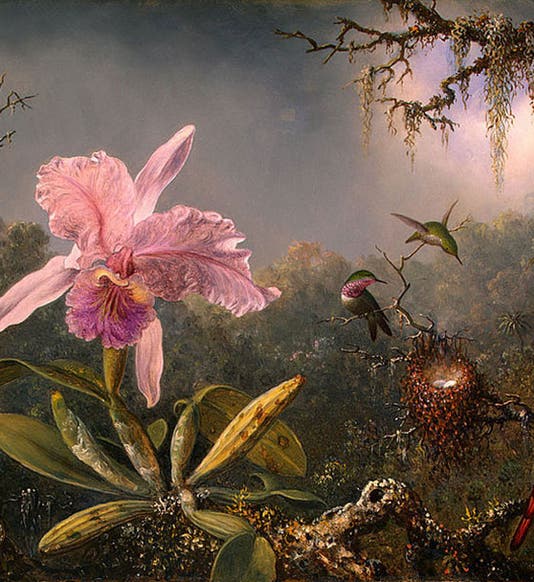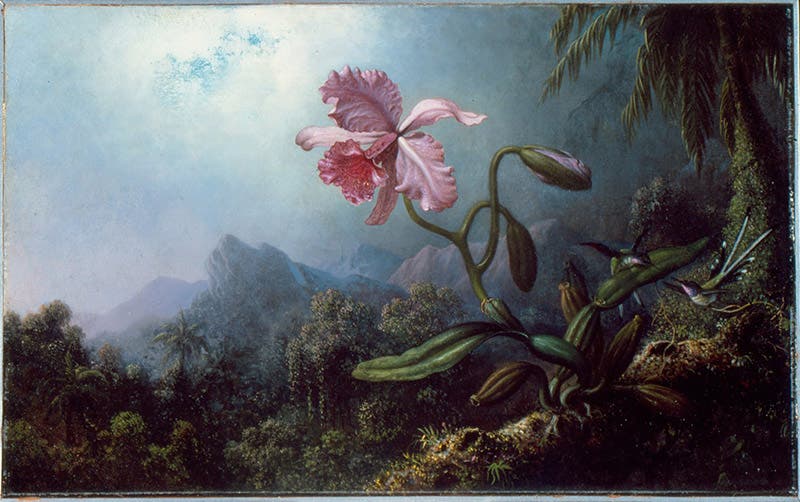Scientist of the Day - Martin Johnson Heade
Martin Johnson Heade, an American artist and naturalist, was born Aug. 11, 1819. Heade wanted to be an artist from his earliest days, and he studied and made friends with various members of the Hudson River school, which turned him toward landscape painting. In 1859, he encountered Frederic Church’s Heart of the Andes, which was on display in its very own gallery in New York City (and is now in the Metropolitan Museum of Art). Heade was blown away, not so much by the painting as by the landscape depicted – the Brazilian tropics. So Heade hightailed it to Brazil, where he met the enlightened monarch of the country, Emperor Dom Pedro II, and the two decided that it would be nice if someone, namely Heade, painted all the hummingbirds that can be found in Brazil, in their natural habitat, and published them in a book. Heade made a series of oil paintings for the project, which he called The Gems of Brazil. For reasons I have not been able to determine, the book was never published, but most of the original oils survive, and they are scattered around in a number of American art museums. We show Cattleya Orchid and Three Brazilian Hummingbirds (1871) at the National Gallery in Washington (first image), Hummingbird and Passionflowers (1875-85) at the Metropolitan Museum of Art in New York (third image), and Two Hummingbirds with an Orchid (1875) at the High Museum in Atlanta (fourth image). As you can see, Heade was as much taken by flora as by fauna, and sometimes the hummingbirds are hard to find.
Heade revisited South America several more times and continued to paint lush tropical landscapes through the 1870s. But he had a bit of a mid-life crisis in his early sixties, when he fell for a 26-year-old married woman, Mabel Loomis Todd. Students of American literature may recognize the name. Heade travelled all the way to Amherst, Mass. to pursue his passion, where he sadly learned that Mabel was all too happy to step outside the bonds of marriage, but not with him – she preferred the somewhat younger and handsomer Austin Dickinson, already married himself, and the older brother of the poet Emily Dickinson. Mrs. Todd pretty much wrecked the Dickinson family with the affair, but after Emily died (in 1886), Mabel Todd was the one who rescued all of Emily’s poems and published them in the succeeding decade.
Heade knew when he wasn't wanted, married another, and moved to Florida and settled into the Ponce de Leon hotel in St. Augustine, where he became resident painter. He now turned toward still lifes, especially those with luxuriant southern flowers that one never saw in his native Pennsylvania. He seems to have loved magnolias, which he would pose on folds of colored cloth as if they were Titian nudes. There are not many artists who can make a flower sexually alluring, but Heade comes close. We show here Magnolias on a Blue Velvet Cloth (1890), in the National Gallery in Washington, D.C. (fifth image), and we link to The Magnolia Blossom (1888), on red velvet, in the Timken Museum of Art in San Diego. The magnolia on blue velvet was later chosen for a postage stamp honoring Heade in 2004, thereby creating an exceptionally attractive commemorative (sixth image).
Heade as artist was almost completely unknown until after World War II, but since his rediscovery, he has been hailed as one of the great 19th-century American naturalist painters, and his works now fetch hundreds of thousands of dollars at auction. Many people acquired Heade paintings in the 1930s for less than a hundred dollars and have been pleasantly pleased by his rise in popularity. Yet another magnolia painting, Magnolias on Gold Velvet Cloth (1880s) was sold to the Museum of Fine Arts, Houston, in 1999 for $1.25 million, after an Indiana man, who had been using it to cover a hole in the wall of his home, inquired of its value from an art dealer. If you frequent garage sales, keep your eye out for hummingbirds, magnolia blossoms, and orchids. A Heade would greatly fatten your 401K.
There seems to be only one portrait of Heade, an undocumented photograph, and for want of another, we show it above (second image). One would think that all artists would be required to paint half-a-dozen self-portraits before they are allowed to mess around with magnolias on velvet.
William B. Ashworth, Jr., Consultant for the History of Science, Linda Hall Library and Associate Professor emeritus, Department of History, University of Missouri-Kansas City. Comments or corrections are welcome; please direct to ashworthw@umkc.edu.












